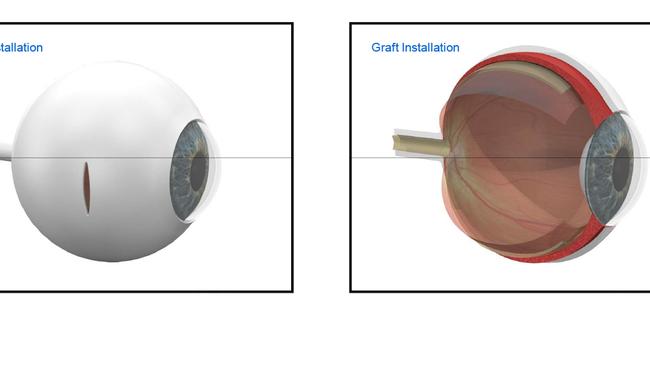Two patients cured of blindness with new stem cell treatment
TWO patients have been cured of blindness with a new stem cell treatment, raising hopes for sufferers of one of the most common forms of vision loss.
News
Don't miss out on the headlines from News . Followed categories will be added to My News.
TWO patients have been cured of blindness with a new stem cell treatment, raising hopes for sufferers of one of the most common forms of vision loss.
Stem cell eye patches transplanted into the eyes of the British patients have been so successful they can now read, despite previously suffering severe age-related macular degeneration.
The breakthrough comes at the same time Australia’s peak stem cell researchers issue a warning for the public to be wary of exploitative commercial clinics which are increasingly marketing less-scientific eye treatments across Australia.
Outlining the breakthrough at a gathering of 2500 international stem cell experts in Melbourne yesterday (SAT), London Project study director Prof Pete Coffey said the results offered significant hope to those with macular degeneration.
“For disease that encroaches in that macula region, you will be unable to read, you will be unable to recognise friends and family and you will be stopped from driving,” Prof Coffey said.

“Prior to the transplant they could hardly read a word. Post transplantation, and a year after, they are actually reading 80-words a minute.”
Age-related macular degeneration, or AMD, is the nation’s leading cause of blindness for people over 40, with about 200,000 Australian’s experiencing vision impairment due to the damage it wrecks on the light-sensitive cells at the centre of the retina.
Current treatments are only able to slow the damage through expensive injections into the eye or laser therapy to seal abnormal blood vessels.
But scientists from University College London and Moorfields Eye Hospital in London grew a 6x3mm patch made of human stem cells over a plastic scaffold, which was then transplanted under the retina in the two patients’ eyes.
Over the following year the stem cells grew into a layer of tissue that provides support for the light-sensitive cells and promoted their regeneration.

Prof Coffey told the International Society for Stem Cell Research’s annual meeting his team had hoped the two patients would be able to read the top three lines on a standard eye test chart — instead they were stunned when they could read six and five lines respectively.
The team are hoping to conduct larger trials to reinforce the results before approaching regulators in the coming years.
At the same time the Royal Australian and New Zealand College of Ophthalmologists and Stem Cells Australia are joining forces to call out the shonky practices on non-regulated clinics selling unproven eye treatments in a wave of private clinics.
The rogue macular degeneration treatments — which can involve using liposuction to remove a patient’s fat and then injecting it into their eye in the hope it will regrow damaged cells — have led to patients suffering detached retinas overseas.
“Unfortunately for too long commercial stem cell clinics operating outside mainstream medicine have made inflated and simplistic claims about ways to restore or save vision,”
Assoc Prof Megan Munsie from Stem Cells Australia said.
“While they may use the language of science, what’s offered by these clinics is effectively a trade in hope.
“We need to draw a greater distinction between legitimate stem cell research and commercial exploitation. Our new resource helps guide patients in their research and hopefully inform discussions with their treating ophthalmologist.”


